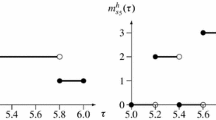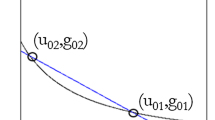Abstract
This paper shows that regime-switching sunspot equilibria easily arise in a one-sector growth model with aggregate decreasing returns and arbitrarily small externalities. We construct a regime-switching sunspot equilibrium under the assumption that the utility function of consumption is linear. We also construct a stochastic optimal growth model whose optimal process turns out to be a regime-switching sunspot equilibrium of the original economy under the assumption that there is no capital externality. We illustrate our results with numerical examples.
Access this chapter
Tax calculation will be finalised at checkout
Purchases are for personal use only
Similar content being viewed by others
Notes
- 1.
- 2.
See Clain-Chamosset-Yvrard and Kamihigashi (2015) for an example of a regime-switching sunspot equilibrium in a two-country model with asset bubbles.
- 3.
Kamihigashi (2015) shows that multiple steady states are possible even without externalities.
- 4.
In the decentralized version of the model, profits are given to consumers, who are the owners of the firms.
- 5.
The condition \(\sigma \in [0,1]\) is needed here.
References
Benhabib, J., & Farmer, R. E. A. (1994). Indeterminacy and increasing returns. Journal of Economic Theory, 63, 19–41.
Benhabib, J., & Farmer, R. E. A. (1999) Chapter 6: Indeterminacy and sunspots in macroeconomics. Handbook of Macroeconomics, 1A, 387–448.
Benhabib, J., Meng, Q., & Nishimura, K. (2000). Indeterminacy under constant returns to scale in multisector economies. Econometrica, 68, 1541–1548.
Brock, W. A. (1982). Asset prices in a production economy. In J. J. McCall (Ed.), The Economics of Information and Uncertainty (pp. 1–46). Press: University of Chicago.
Brock, W. A., & Mirman, L. J. (1972). Optimal economic growth and uncertainty: The discounted case. Journal of Economic Theory, 4, 479–513.
Clain-Chamosset-Yvrard, L., & Kamihigashi, T. (2015). International transmission of bubble crashes: Stationary sunspot equilibria in a two-country overlapping generations model, RIEB Discussion Paper DP2015-21, Kobe University.
Coury, T., & Wen, Y. (2009). Global indeterminacy in locally determinate real business cycle models. International Journal of Economic Theory, 5, 49–60.
Dos Santos Ferreira, R., & Lloyd-Braga, T. (2008). Business cycles with free entry ruled by animal spirits. Journal of Economic Dynamics and Control, 32, 3502–3519.
Drugeon, J.-P., & Wigniolle, B. (1996). Continuous-time sunspot equilibria and dynamics in a model of growth. Journal of Economic Growth, 69, 24–52.
Drugeon, J.-P., & Venditti, A. (2001). Intersectoral external effects, multiplicities & indeterminacies. Journal of Economic Dynamics and Control, 25, 765–787.
Dufoourt, F., Nishimura, K., & Vendittie, A. (2015). Indeterminacy and sunspots in two-sector RBC models with generalized no-income-effect preferences. Journal of Economic Theory, 157, 1056–1080.
Ekeland, I., & Scheinkman, S. A. (1986). Transversality conditions for some infinite horizon discrete time optimization problems. Mathematics of Operations Research, 11, 216–229.
Farmer, R. E. A., & Guo, J.-T. (1994). Real business cycles and the animal spirits hypothesis. Journal of Economic Theory, 63, 42–72.
Grandmont, J.-M. (1989). Local bifurcation and stationary sunspots. Economic Complexity: Chaos, Sunspots, Bubbles, and Nonlinearity (pp. 45–60).
Grandmont, J.-M. (1991). Expectations driven business cycles. European Economic Review, 35, 293–299.
Kamihigashi, T. (1996). Real business cycles and sunspot fluctuations are observationally equivalent. Journal of Monetary Economics, 37, 105–117.
Kamihigashi, T. (1999). Chaotic dynamics in quasi-static systems: Theory and applications. Journal of Mathematical Economics, 31, 183–214.
Kamihigashi, T. (2002). Externalities and nonlinear discounting: Indeterminacy. Journal of Economic Dynamics and Control, 26, 141–169.
Kamihigashi, T. (2003). Necessity of transversality conditions for stochastic problems. Journal of Economic Theory, 109, 140–149.
Kamihigashi, T. (2005). Necessity of the transversality condition for stochastic models with bounded or CRRA utility. Journal of Economic Dynamics and Control, 29, 1313–1329.
Kamihigashi, T. (2008). Stochastic optimal growth with bounded or unbounded utility and with bounded or unbounded shocks. Journal of Mathematical Economics, 43, 477–500.
Kamihigashi, T. (2015). Multiple interior steady states in the Ramsey model with elastic labor supply. International Journal of Economic Theory, 11, 25–37.
Mino, K. (2001). Indeterminacy and endogenous growth social constant returns. Journal of Economic Theory, 97, 203–222.
Pelloni, A., & Waldmann, R. (1998). Stability properties of a growth model. Economics Letters, 61, 55–60.
Pintus, P. A. (2006). Indeterminacy with almost constant returns to scale: Capital-labor substitution matters. Economic Theory, 28, 633–649.
Puterman, M. L. (2005). Markov Decision Processes: Discrete Stationary Dynamic Programming. Hoboken, NJ: John Wiley & Sons.
Author information
Authors and Affiliations
Corresponding author
Editor information
Editors and Affiliations
Appendices
Appendix A Proof of Lemma 6.3.1
Let \(\{c^{*}_{t}, n^{*}_{t}, k^{*}_{t}\}_{t=0}^{\infty }\) be a feasible process satisfying (6.3.4)–(6.3.6) (with \(c^{*}_{t}, n^{*}_{t}, k^{*}_{t}\) replacing \(c_{t}, n_{t}, k_{t}\)). To simplify notation, for \(t \in \mathbb {Z}_{+}\) and \(i = 1,2\) we define
We are to show that for any feasible process \(\{c_{t}, n_{t}, k_{t}\}_{t=0}^{\infty }\), we have
To this end, let \(\{c_{t}, n_{t}, k_{t}\}_{t=0}^{\infty }\) be a feasible process. Fix \(T \in \mathbb {N}_{+}\) for the moment. Let
where \(u'(c^{*}_{t})\) is the right derivative of u at 0 if \(c^{*}_{t} = 0\), and similarly for \(w'(n^{*}_{t})\). We have
Recalling the first-order condition (6.3.4) for \(n_{t}\), we see that for all \(t \in \mathbb {Z}_{+}\),
Substituting into (6.5.7) we obtain
where the last equality holds by the law of iterated expectations. Recalling the Euler condition (6.3.5) for \(k_{t+1}\), we see that for all \(t \in \mathbb {Z}_{+}\),
Substituting into (6.5.13) we obtain
where the second inequality holds since \(k_{T+1} \geqslant 0\), and the convergence holds by the transversality condition (6.3.6). This completes the proof of Lemma 6.3.1.
Appendix B Proof of Proposition 6.4.1
Suppose that \(\sigma = 0\). Then conditions (6.4.5) and (6.4.6) can be written as
The Euler condition for \(k_{t+1}\), (6.3.5), can be written as
The transversality condition (6.3.6) reduces to
Note that (6.5.17) and (6.5.18) can be combined into
Substituting into the left-hand side of (6.5.19) we obtain
where
Both expressions in the curly brackets are strictly decreasing in k by (6.2.10) and (6.2.12) (note that \((\alpha +\overline{\alpha }-1)(\gamma +1) + \rho + \overline{\rho } < \alpha + \overline{\alpha } -1 + \rho + \overline{\rho } \leqslant 1\) by (6.2.12)). Thus \(h(\cdot )\) is strictly decreasing, which implies that the inverse \(h^{-1}(\cdot )\) exists. Indeed, for \(z > 0\) we have
Note that
Substituting (6.5.22)–(6.5.24) into (6.5.19) we obtain
where \(p_{s_{t}1} = p_{01}\) or \(p_{11}\) depending on \(s_{t} = 0\) or 1. For \(p > 0\) define
Note from (6.5.28) that we can rule out the case \(k_{t+1} = 0\) in (6.5.29). Hence we can write (6.5.29) as
We construct a process \(\{c_{t}, n_{t}, k_{t}\}_{t=0}^{\infty }\) recursively as follows: given \(k_{t} > 0\) and \(s_{t} \in \{0,1\}\), let
Determine \(k_{t+1}\) by (6.5.31). Let
Draw \(s_{t+1}\) according to (6.4.1). Determine \(n_{t+1}\) by (6.5.32), and so on. By construction, this process is feasible and satisfies (6.5.17)–(6.5.19). It also satisfies (6.5.20) by (6.2.13). Thus it is a sunspot equilibrium. The conclusion of the proposition now follows.
C Proof of Proposition 6.4.2
Suppose that \(\overline{\alpha } = 0\). Consider the stochastic optimal growth model (6.4.17)–(6.4.19). The Euler condition for \(k_{t+1}\) is written as
This is equivalent to the equilibrium Euler condition (6.3.5) for \(k_{t+1}\) for the original economy (6.2.1)–(6.2.3) with \(\overline{\alpha } = 0\) and (6.4.3). The first-order condition for \(n_{t}\) for the above stochastic optimal growth model is given by
which simplifies to
This is equivalent to (6.3.4) with \(\overline{\alpha } = 0\) and (6.4.3). The transversality condition for the above problem is identical to (6.3.6).
Conditions (6.5.34) and (6.5.36) are necessary for optimality by standard arguments. The transversality condition (6.3.6) is also necessary by the argument of Kamihigashi (2005, Sect. 6).Footnote 5 Given that the sunspot variable \(s_{t}\) is discrete, we can easily establish the existence of an optimal process for the optimal stochastic growth model (6.4.17)–(6.4.19) by a standard argument (e.g., Ekeland and Scheinkman 1986). Let \(\{c_{t}, n_{t}, k_{t}\}_{t=0}^{\infty }\) be an optimal process for (6.4.17)–(6.4.19). Then by the above argument, the process satisfies (6.3.4)–(6.3.6). Thus by Lemma 6.3.1, the process is an equilibrium of the original economy (6.2.1)–(6.2.3). Since it depends on \(s_{t}\) in a nontrivial way, it is a sunspot equilibrium.
Rights and permissions
Copyright information
© 2017 Springer International Publishing AG
About this chapter
Cite this chapter
Kamihigashi, T. (2017). Regime-Switching Sunspot Equilibria in a One-Sector Growth Model with Aggregate Decreasing Returns and Small Externalities. In: Nishimura, K., Venditti, A., Yannelis, N. (eds) Sunspots and Non-Linear Dynamics. Studies in Economic Theory, vol 31. Springer, Cham. https://doi.org/10.1007/978-3-319-44076-7_6
Download citation
DOI: https://doi.org/10.1007/978-3-319-44076-7_6
Published:
Publisher Name: Springer, Cham
Print ISBN: 978-3-319-44074-3
Online ISBN: 978-3-319-44076-7
eBook Packages: Economics and FinanceEconomics and Finance (R0)




